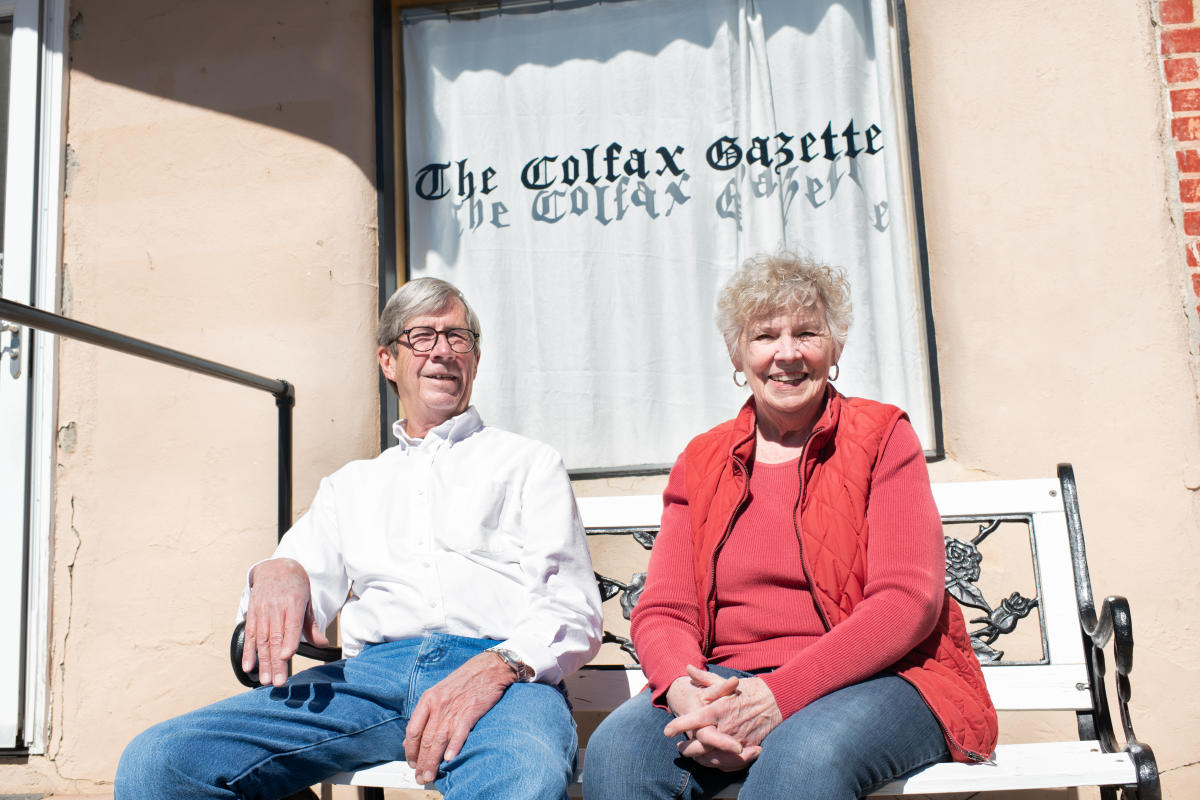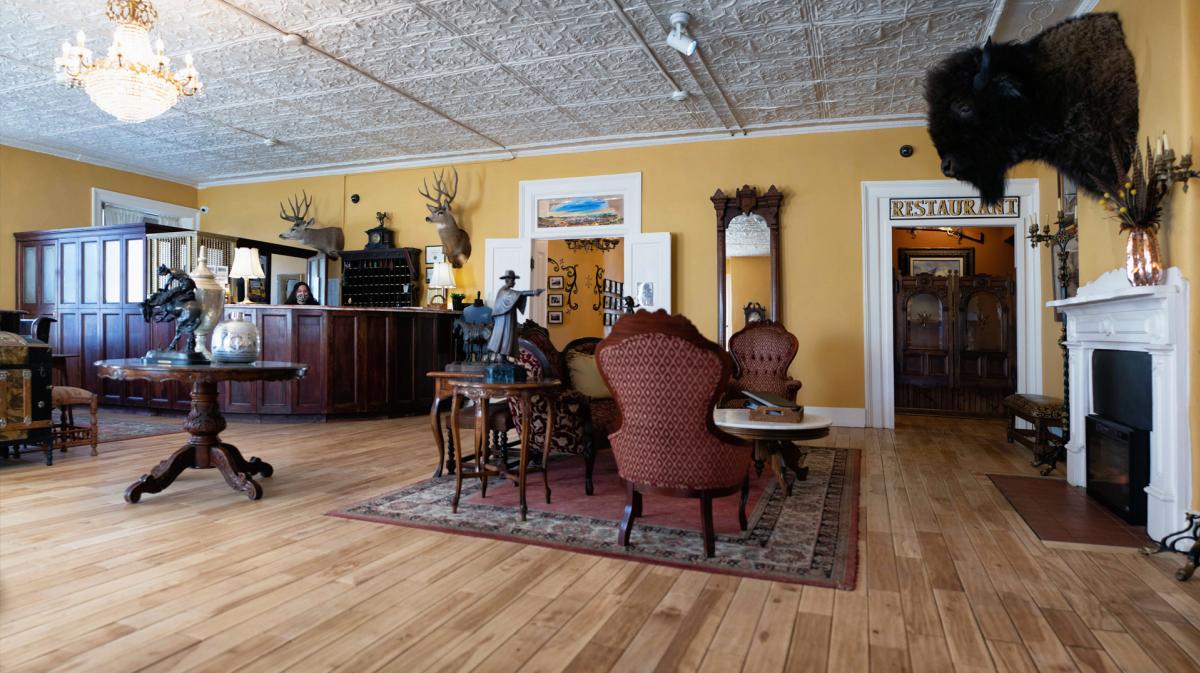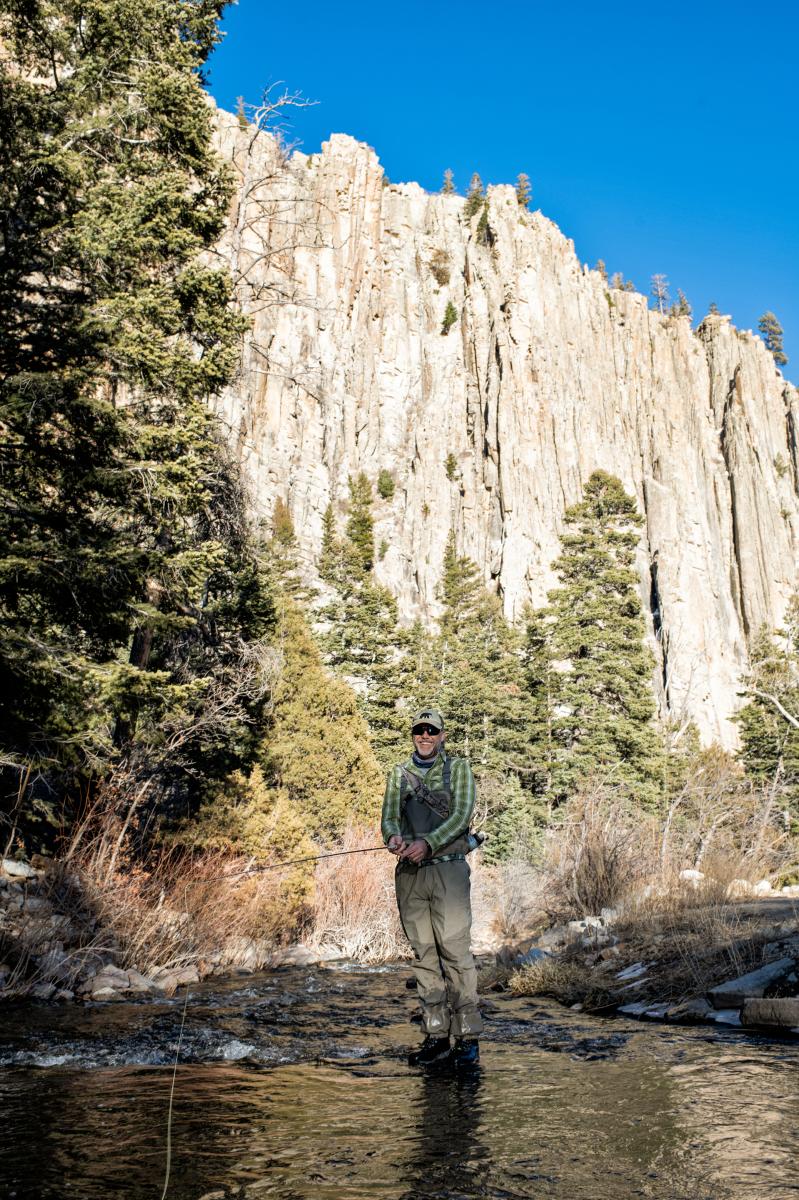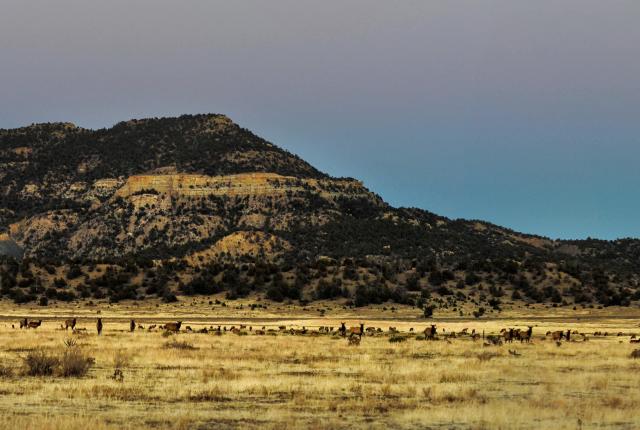A WIDE-OPEN SKY ROLLS DOWN the eastern edge of the Sangre de Cristo Mountains into the village of Cimarrón. Wire fences line pastures of tall grasses colored tan and copper, and ranches stretch from the town to the horizon in all directions. Rocky bluffs arch skyward north and west of Cimarrón, like scenery pulled from a spaghetti western. “Downtown” is just a few blocks bordering a park and visitor center. Streets are spotted with old adobe homes mixed with more modern houses and a few storefronts on US 64. The occasional dust-caked pickup rumbles in from the range, but otherwise traffic is almost nonexistent.
As I drive into town on a blustery winter day, I don’t know a soul. But I’ll soon learn it’s an easy place to make a friend—so long as you’re not looking for big-city amenities.
“There are no stoplights here,” says Roger Smith. “If they put one in, we might have to move.”
Smith grew up in the area in the 1950s and, like a lot of folks, moved away, looking for better job opportunities. Eventually he came back, ran a couple of businesses, then “retired” in order to open The Colfax Gazette with his sister, Sharon Smith. They’ve been pumping out an issue every other week for two years now, covering village council meetings and sharing coupons for cold beer at the local tavern.
 Brother and sister Roger and Sharon Smith, owners of The Colfax Gazette.
Brother and sister Roger and Sharon Smith, owners of The Colfax Gazette.
History and the sometimes hard conditions of mountain life bind residents together. When the Ute Park Fire raged through Cimarrón Canyon and the Philmont Scout Ranch in 2018, the community’s Facebook page lit up with pleas for and offers of help. Who needs water? My baby needs milk. Leave your horses in my corral. The burn scars on the mountainsides bear witness to how near the danger came. All around Cimarrón, evidence of what residents’ forebears endured does the same.
“History is one of the biggest assets this town has,” Smith says. “And the Colfax County War is a large part of that history.”
The story goes like this: In the mid-1800s, Lucien B. Maxwell owned the land grant that included Cimarrón—a massive 1.7-million-acre spread once held by Spanish colonists— and had handshake agreements with many of the land’s first tenants. They could graze their cows, cut some timber.
“But nothing was written,” Smith says. “Nothing was on paper.”

The Dawson Cemetery’s solemn markers.
Conflicts began around 1870, when Maxwell sold the grant, which wound up in the hands of English investors backed by the politically connected Santa Fe Ring. In 1875, hostilities turned deadly in a town whose very name is Spanish for wild or uncivilized. “Cimarrón is in the hands of a mob,” The Santa Fe New Mexican reported that November.
The U.S. Supreme Court eventually decided in favor of the new owners in 1887, quelling the killings, although the evictions lasted into 1894. “After the Colfax County War,” Smith says, “the area thrived with timber, ranching, and coal mining. But all of that dissipated by World War II.” Jobs moved to cities, and so did residents. “Since then, the town has been around a thousand people,” Smith says.
 Victorian style meets the Wild West in the St. James Hotel lobby.
Victorian style meets the Wild West in the St. James Hotel lobby.
EAGER TO LEARN MORE, I SET OUT on a self-guided walking tour of historical sites, heading down Collison Avenue (NM 21) to the south end of town. The tour encompasses about five blocks and features the original site of the Maxwell family house and graveyard, the old jail, and the Immaculate Conception Catholic Church. Many of the buildings from the 1800s still stand today.
Another stop on the walking tour is the Old Mill Museum, a hulking three-story gristmill that displays relics from the area, including Maxwell’s daughter’s wedding dress and a two-headed calf. A main attraction, though, has to be the St. James Hotel, dead center on the walking tour. Said to be haunted by at least one ghost, it offers guests a choice of one of the historical rooms or more modern amenities in a newer wing, plus a place to wet your whistle in an old-time saloon. The two-story hotel, built in 1872, has a long history of housing ruffians and lawmen of the Old West, including famous figures like Jesse James, Billy the Kid, Clay Allison, and Wyatt Earp.
 One of the historic rooms at the St. James Hotel.
One of the historic rooms at the St. James Hotel.
Worn leather furniture and shiny tin lamps emitting dim yellow light fill the lobby, ornate chandeliers hang above hallways, and the wooden floorboards creak with age. Paintings and old photographs show cowboys and settlers crossing desert ranges long ago.
“We have not only the ghost stories, but the historic atmosphere our owner has been able to provide and keep going,” says Matthew Mayfield, who works at the front desk. “It makes for a great charm in this part of nowhere.”
Alas, the pandemic means that TJ’s, the rustic saloon, is closed. But Lambert’s, the restaurant named for founder Henri Lambert, is still open (try the Pancho Griego Enchiladas), and the bar serves alcohol on the patio, inside one of the “table tents.” Breakfast, lunch, and dinner are available, with classic items like French toast and bacon burgers, as well as smothered burritos and spicy chicken wraps.
Other small-scale entrepreneurs have likewise tried to muscle through the closures, among them the Blue Moon Art & Gift Gallery and the Cimarrón Candle Company. One of the newest businesses, Hikers Coffee Company, opened seven months into the lockdown.
Melissa Warner says her family fell in love with the town years ago and finally made the move from Houston. Their building once housed the Cimarrón Art Gallery, which had a classic soda fountain, and its counter is still used to section off the coffee and espresso machines. “I think we’ve got the right formula for this,” Warner says.
After watching numerous customers pop in for coffee and sweets, it looks like she’s right, but there’s no denying that the pandemic slowed tourism down. “We expected the tourists to be our bread and butter,” Warner says. Instead, what makes it work is the community and their apparent love of the shop’s Hot Chocolate Bombs, she says. “It’s the town that’s come together to support us. This town, it’s living and breathing—it’s got a heartbeat.”
 Julia Stafford, owner of the Cimarrón Mercantile.
Julia Stafford, owner of the Cimarrón Mercantile.
COAL-MINING JOBS LONG FED THIS REGION'S economy, from Cimarrón to Ratón. On my final day, I drive up a five-mile dirt road northeast of Cimarrón to see the remains of what once was the largest company town in New Mexico. At its peak, Dawson, a Phelps Dodge Corporation mining town, was home to 6,000 people, most of them European immigrants, along with a hospital, theater, bowling alley, train stop, and professional minor league baseball team (the Stags). Aside from the memories of those who lived there, only a lonely graveyard remains today.
In 1913, a mining explosion claimed the lives of 263 people, making it one of the largest mining disasters in U.S. history. A decade later a second blast, sparked by a derailed mining car, killed 123 miners, some before they’d reached their 21st birthday. The souls who were lost are commemorated on a large sign that stands before their section of the cemetery, each man’s grave marked with a white cross.
Read More: The Historic Fairview Cemetery tells stories of wealth, power, tragedy, and anonymity.
You can hear the wind in the juniper trees, a few birdsongs, but nothing else. Still, a sense of what once was is palpable. Maybe it’s all those names on the graves turning into voices from the past, alive and chatting, murmuring a prayer, or cheering on a line drive. Almost no structures stand in Dawson today. When the mine closed in 1950, buildings were demolished or hauled away for liability reasons. A few houses were moved to Cimarrón. The Dawson site is still well loved by the town’s descendants, who attempt a reunion every two years. The people, like the land, hold their memories close.

Shane Clawson of High Country Anglers dips a line in the Cimarrón River.
Get Historical
Cimarrón boasts a range of lodging options, including vacation rentals and campgrounds, as well as shops, restaurants, hiking trails, and prime fly-fishing spots. Ghost hunters: Check into the St. James Hotel.
Soak up history at the area’s five museums, including the in-town Old Mill Museum, housed in a three-story gristmill built by Lucien Maxwell and open during the summer.
Nearby, the Philmont Scout Ranch has four museums. Open year-round, the National Scouting Museum features the work of Susan Norris, the official artist for the Boy Scouts of America, in its gift shop. Villa Philmonte was once the 28,400-square-foot home of Waite and Genevieve Phillips, former owners of the ranch, and is open spring through fall. Costumed interpreters tell territorial-era stories summer through fall at the Kit Carson Museum at Rayado. The Chase Ranch History Museum, open summer through fall, showcases ranch life from the Colfax County War to contemporary times.
To see the Dawson Cemetery, drive 12 miles east on US 64 from Cimarrón. Turn left onto County Road A38 (just before the Colfax Tavern and its “cold beer” sign). Drive 5 miles up the road, which ends at the cemetery. The road is dirt and cell service is spotty. Check the weather before you go. The cemetery is open to visitors but surrounded by private ranchland; do not trespass on it.


